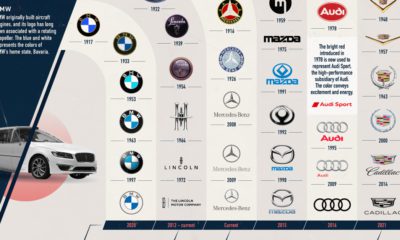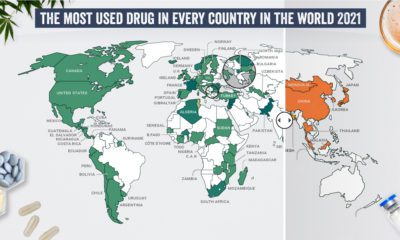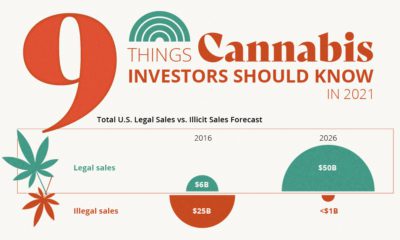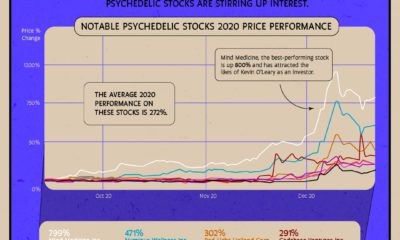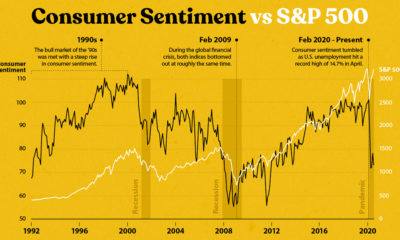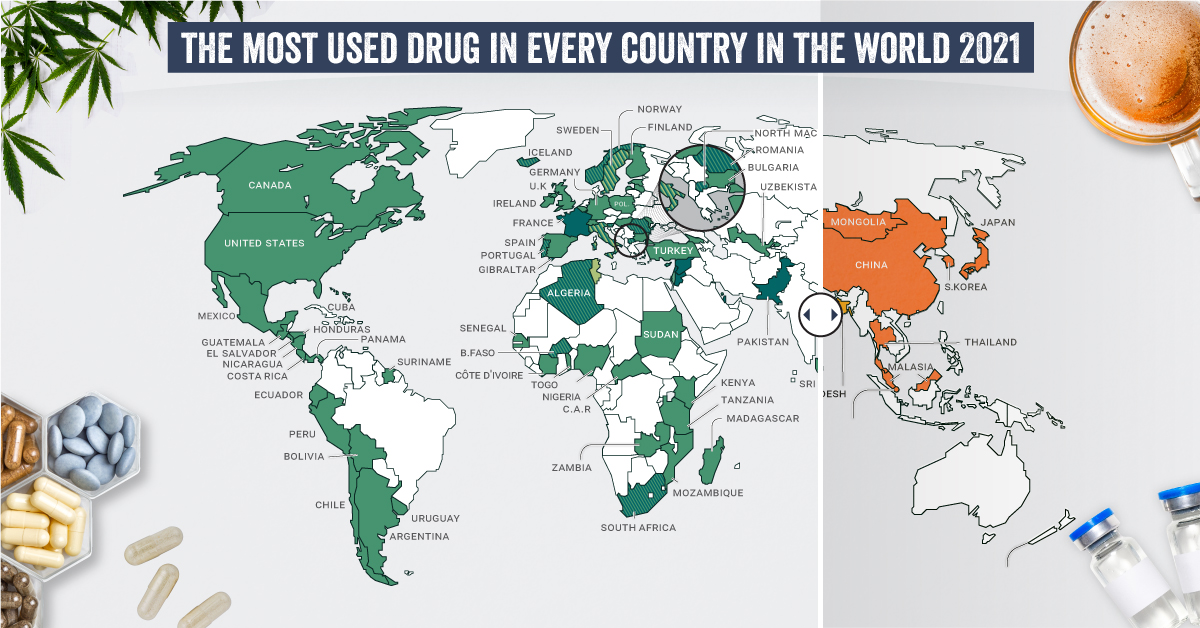What’s driving the evolution of the market? Cannabis is in the midst of a shakeup, and today’s infographic from Ionic Brands highlights how consumers are significantly shaping the landscape of cannabis.
Cannabis Concentrates: A New Frontier
For years, joints and blunts dominated the industry—but sales of traditional flower are swiftly losing ground to new products. Here’s how cannabis consumer spending looks across North America in a few short years: Cannabis consumers are clearly moving away from simply smoking the product. Concentrates are the fastest growing industry segment, which is not surprising since they’re needed to make all sorts of products, from edibles to topicals and tinctures. Cannabis concentrates are also discreet, convenient, and more potent than other cannabis products, all of which contribute to their consumer appeal. In fact, these changing preferences are disrupting other mammoth industries. Take JUUL Labs for example: the inconspicuous, smokeless device is chipping away at the tobacco industry, and now accounts for almost 73% of the e-cigarette market. JUUL’s growth is proof that consumers are driving the market, and this trend is also reflected in cannabis. Among all cannabis concentrate types, vaporizers (vapes) overwhelmingly come out on top in established markets, accounting for 43% of sales in Colorado, 70% in Oregon, and 79% in California.
Branding is Everything in Cannabis
The cannabis concentrates space is becoming increasingly sophisticated. With more money to be made from less product, concentrates offer higher margins as well. But in a fragmented market, brand recognition is arguably the biggest factor guiding consumer demand. Returning to JUUL’s example, the company’s branding played a big hand in its accelerated trajectory—and in grabbing the attention of major players like Altria, the corporate parent of Marlboro. Altria made a landmark investment into 35% of JUUL in December 2018, bringing the latter’s value up to $38 billion. In the nascent cannabis industry, consumers are still wondering who they can trust. A recent survey revealed that 72% of cannabis consumers rated branding as somewhat or very important in assessing a product’s quality and safety. Branded cannabis products are on the rise, but they’re not as established as Starbucks coffee or Apple iPhones quite yet. When done right, cannabis concentrates brands are able to capture quite a significant chunk of the market:
California Top 10 brands: 48.4% All other: 51.6% Colorado Top 10 brands: 46.6% All other: 53.4% Oregon Top 10 brands: 59.7% All other: 40.3%
In a budding industry, such brand market domination is an impressive feat. However, a few barriers still stand in the way of these brands’ ability to scale on a national level: cannabis and related products aren’t legal in every U.S. state, while diverse state regulations also complicate the process. Cannabis consumer brands that can spread out into multiple states, and develop consumer trust, will emerge as winners in this new, dynamic market. on Humans have a storied and complicated relationship with drugs. Defined as chemical substances that cause a change in our physiology or psychology, many drugs are taken medicinally or accepted culturally, like caffeine, nicotine, and alcohol. But many drugs—including medicines and non-medicinal substances taken as drugs—are taken recreationally and can be abused. Each country and people have their own relationship to drugs, with some embracing the use of specific substances while others shun them outright. What are the most common drugs that are considered generally illicit in different parts of the world? Today’s graphics use data from the UN’s World Drug Report 2021 to highlight the most prevalent drug used in each country.
What Types of Common Drugs Are Tracked?
The World Drug Report looks explicitly at the supply and demand of the international illegal drug market, not including commonly legal substances like caffeine and alcohol. Drugs are grouped by class and type, with six main types of drugs found as the most prevalent drugs worldwide.
Cannabis*: Drugs derived from cannabis, including hemp. This category includes marijuana (dried flowers), hashish (resin), and other for various other parts of the plant or derived oils. Cocaine: Drugs derived from the leaves of coca plants. Labeled as either cocaine salts for powder form or crack for cocaine processed with baking soda and water into rock form. Opioids: Includes opiates which are derived directly from the opium poppy plant, including morphine, codeine, and heroin, as well as synthetic alkaloids. Amphetamine-type Stimulants (ATS): Amphetamine and drugs derived from amphetamine, including meth (also known as speed), MDMA, and ecstasy. Sedatives and Tranquilizers: Includes other drugs whose main purpose is to reduce energy, excitement, or anxiety, as well as drugs used primarily to initiate or help with sleep (also called hypnotics). Solvents and Inhalants: Gases or chemicals that can cause intoxication but are not intended to be drugs, including fuels, glues, and other industrial substances.
The report also tracked the prevalence of hallucinogens—psychoactive drugs which strongly affect the mind and cause a “trip”—but no hallucinogens ranked as the most prevalent drug in any one country. *Editor’s note: Recreational cannabis is legal in five countries, and some non-federal jurisdictions (i.e. states). However, in the context of this report, it was included because it is still widely illicit in most countries globally.
The Most Prevalent Drug in Each Country
According to the report, 275 million people used drugs worldwide in 2020. Between the ages of 15–64, around 5.5% of the global population used drugs at least once. Many countries grouped different types of the same drug class together, and a few like Saudi Arabia and North Macedonia had multiple different drug types listed as the most prevalent. But across the board, cannabis was the most commonly prevalent drug used in 107 listed countries and territories: How prevalent is cannabis worldwide? 72 locations or more than two-thirds of those reporting listed cannabis as the most prevalent drug. Unsurprisingly these include countries that have legalized recreational cannabis: Canada, Georgia, Mexico, South Africa, and Uruguay.
How Common Are Opioids and Other Drugs?
Though the global prevalence of cannabis is unsurprising, especially as it becomes legalized and accepted in more countries, other drugs also have strong footholds. Opioids (14 locations) were the most prevalent drugs in the Middle-East, South and Central Asia, including in India and Iran. Notably, Afghanistan is the world’s largest producer of opium, supplying more than 90% of illicit heroin globally. Amphetamine-type drugs (9 locations) were the third-most common drugs overall, mainly in East Asia. Methamphetamine was the reported most prevalent drug in China, South Korea, and Japan, while amphetamine was only the most common drug in Bangladesh. However, it’s important to note that illicit drug usage is tough to track. Asian countries where cannabis is less frequently found (or reported) might understate its usage. At the same time, the opioid epidemic in the U.S. and Canada reflects high opioid usage in the West. As some drugs become more widespread and others face a renewed “war,” the landscape is certain to shift over the next few years.
